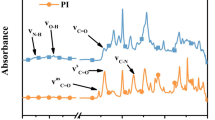Abstract
We have investigated the influence of drawing on orientation, crystallinity, and structural properties of polyamide 6 films using X-ray diffraction. The samples were uniaxially and biaxially stretched resulting in the formation of monoclinic crystallites (α-form) in the size range of 8–10 nm. Depending on the drawing ratio, a degree of crystallinity of up to 60% is obtained. The average orientation of the crystallite axes was evaluated using the pole figure technique. The b*-axis, which corresponds to the chain direction of the polyamide molecules, lies in the film plane and shows a preferred orientation upon drawing. For uniaxial drawing, b* aligns with the drawing direction. For biaxially drawn films, which were prepared using the sequential stretching method, the second drawing determines the orientation of b*, at least at the center of the films. At the sides, b* is located between the two drawing directions reflecting the inhomogeneous distribution of mechanical stress during stretching.













Similar content being viewed by others
References
Vasanthan N (2003) J Polym Sci: Part B: Polym Phys 41:2870
Beltrame P, Citterio C, Testa G, Seves A (1999) J Appl Polym Sci 74:1941
Arimoto H, Ishibashi M, Hirai M, Charani Y (1956) J Polym Sci: Part A 3:317
Stepaniak RF, Garton A, Carlsson DJ, Wiles DM (1979) J Appl Polym Sci 23:1747
Parker J, Lindenmeyer P (1977) J Appl Polym Sci 21:821
Holmes D, Bunn C, Smith J (1955) J Polym Sci 17:159
Huisman R, Heuvel H, Lind K (1976) J Polym Sci Polym Phys 14:921
Huisman R, Heuvel H (1976) J Polym Sci Polym Phys 14:941
Desper C, Stein R (1966) Journal of Applied Physics 37:3990
Decker B, Asp E, Harker D (1948) J Appl Phys 19:388
Riello P, Fagherazzi G, Canton P (1998) Acta Cryst A 54:219
Alexander L (1971) X-ray diffraction methods in polymer science. Wiley-Interscience, New York
Williamson G, Hall W (1953) Acta Metall 1:22
Dencheva N, Denchev Z, Oliveira M, Funari S (2007) J Appl Polym Sci 103:2242
Author information
Authors and Affiliations
Corresponding author
Appendix
Appendix
Some sample rotations were done during the measurement of the X-ray diffractograms in order to be sure about indexing the film reflections, to detect more peaks, and to separate the overlapping ones. In general, the rotations were done in κ and β angles as sketched in Fig. 14a. Figure 14b shows the transmission intensity of the XRD patterns of the biaxially drawn film taken from the left side (L; see Fig. 2b). The film was continuously spun in κ angle during the measurement. A comparison with Figs. 4 and 5 shows that new peaks appear.
a A schematic representation of the rotation angles β and κ. b Transmission intensity of XRD patterns of a biaxially drawn Polyamide 6 film, taken at its left side (L; see Fig. 2b). The film was continuously spun around the κ angle during the 2θ scan (In Figs. 14b, 15 and 16 data of Mo Kα radiation were converted into equivalent Cu Kα radiation for comparison)
Figure 15 presents the transmission XRD patterns of the same film, but now the angle β was fixed at +30, 0, and −30 degrees during the 2θ scan. At β = −30°, the peaks 200 at 2θ = 20.5° and 002/202 at 2θ = 24.05°, which were previously overlapping (at 2θ = 20°–25°), can be separated. In Fig. 16, the angle κ was changed and β was kept constant at 30°. So it was possible to separate the 200 and 002 peaks, and to detect others such as the 006 peak, especially at β = 30° and κ = 45°.
Rights and permissions
About this article
Cite this article
Shanak, H., Ehses, KH., Götz, W. et al. X-ray diffraction investigations of α-polyamide 6 films: orientation and structural changes upon uni- and biaxial drawing. J Mater Sci 44, 655–663 (2009). https://doi.org/10.1007/s10853-008-3062-7
Received:
Accepted:
Published:
Issue Date:
DOI: https://doi.org/10.1007/s10853-008-3062-7







